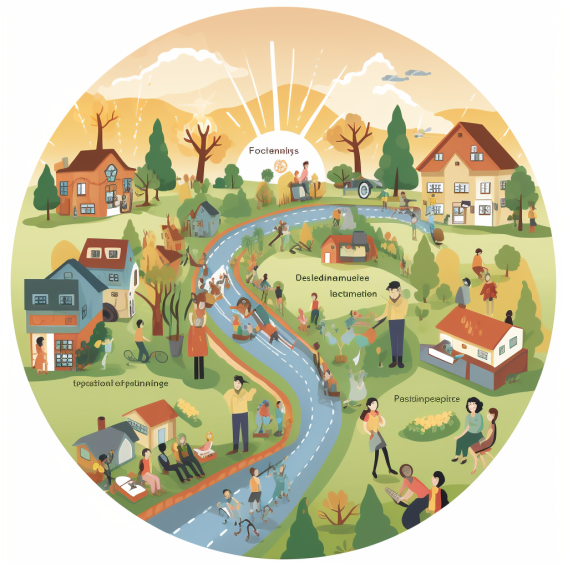The well-being of a community is intricately connected to the health of its environment. Embracing sustainable practices not only benefits the planet but also enhances the quality of life for residents. This article explores the significance of sustainable initiatives in fostering community well-being, examining practices that promote environmental harmony, economic resilience, and social equity.
The Intersection of Sustainability and Well-Being
1. Environmental Stewardship
Sustainable practices prioritize environmental stewardship. Implementing initiatives such as waste reduction, conservation of natural resources, and green infrastructure projects contributes to a healthier environment, positively impacting the well-being of both residents and ecosystems.
2. Economic Resilience
Sustainability fosters economic resilience within communities. Supporting local businesses, promoting green industries, and investing in renewable energy initiatives create a robust economic foundation, ensuring long-term prosperity for residents.
3. Social Equity and Inclusion
Sustainable practices strive for social equity and inclusion. From affordable housing projects to community gardens, initiatives that prioritize accessibility and fairness contribute to a more equitable distribution of resources and opportunities within the community.
Sustainable Practices Across Domains
4. Renewable Energy Adoption
Transitioning to renewable energy sources is a key sustainable practice. Communities can explore solar, wind, and other renewable energy options, reducing dependence on fossil fuels and mitigating the impact of climate change.
5. Waste Reduction and Recycling Programs
Implementing waste reduction and recycling programs minimizes environmental impact. These initiatives promote responsible consumption, reduce landfill waste, and contribute to a cleaner and healthier community.
6. Community Gardens and Local Agriculture
Community gardens and local agriculture initiatives promote sustainable food practices. Residents can actively participate in growing their own food, fostering a sense of connection to the land and encouraging healthier eating habits.
Strategies for Community Adoption
7. Education and Awareness Campaigns
Educational campaigns raise awareness about the benefits of sustainable practices. Workshops, seminars, and informational materials help residents understand the impact of their choices on the environment and community well-being.
8. Green Infrastructure Development
Investing in green infrastructure, such as parks, green spaces, and sustainable building practices, enhances the aesthetic appeal of the community while promoting environmental sustainability and overall well-being.
9. Collaboration with Local Businesses
Collaborating with local businesses encourages the adoption of sustainable practices. Community partnerships can lead to the development of eco-friendly initiatives, sustainable product lines, and environmentally conscious business strategies.
Overcoming Challenges
10. Inclusive Decision-Making Processes
Inclusive decision-making processes ensure that sustainable practices consider the diverse needs of the community. Engaging residents in discussions and decision-making regarding sustainability initiatives fosters a sense of ownership and inclusivity.
11. Accessible Green Spaces
Ensuring access to green spaces for all residents is crucial. Sustainable practices should prioritize the creation and maintenance of accessible parks and recreational areas, promoting physical and mental well-being.
12. Affordable Housing and Energy Solutions
Addressing affordability in housing and energy solutions is essential for widespread adoption. Sustainable practices should include initiatives that make green technologies, energy-efficient homes, and eco-friendly living options accessible to all income levels.
Success Stories in Sustainable Community Well-Being
13. Zero-Waste Communities
Communities that successfully adopt zero-waste practices showcase the transformative impact of sustainable living. By prioritizing reduction, reuse, and recycling, these communities minimize their environmental footprint and inspire others to follow suit.
14. Community-Led Renewable Energy Projects
Community-led renewable energy projects have empowered residents to take control of their energy sources. Initiatives such as community solar installations or local wind farms demonstrate the potential for sustainable practices to enhance community resilience.
The Future of Sustainable Community Well-Being
15. Smart City Integration
Integrating smart city technologies enhances sustainability. From energy-efficient infrastructure to data-driven waste management, smart city initiatives can optimize resources and improve the overall well-being of residents.
16. Circular Economy Practices
Embracing circular economy practices reduces waste and promotes resource efficiency. Communities can explore initiatives such as recycling programs, upcycling projects, and product-sharing platforms to build a more sustainable and resilient local economy.
Conclusion
Sustainable practices are foundational to the well-being of communities, fostering a harmonious balance between human activities and the environment. By actively adopting and promoting initiatives that prioritize sustainability, communities can create a legacy of resilience, inclusivity, and environmental stewardship. As we navigate the challenges of the present and look towards the future, sustainable practices stand as a beacon, guiding communities towards a path of enduring well-being for generations to come.



